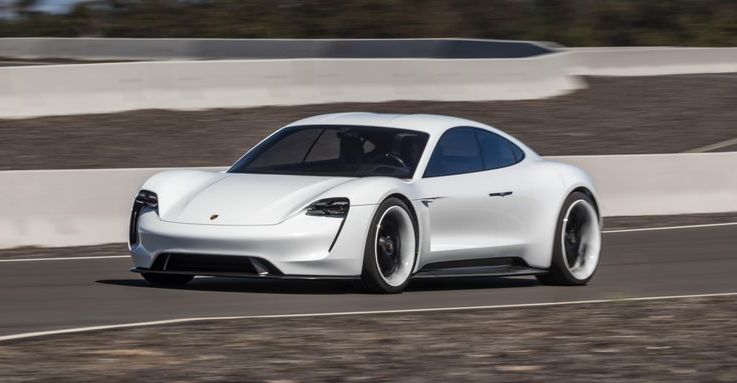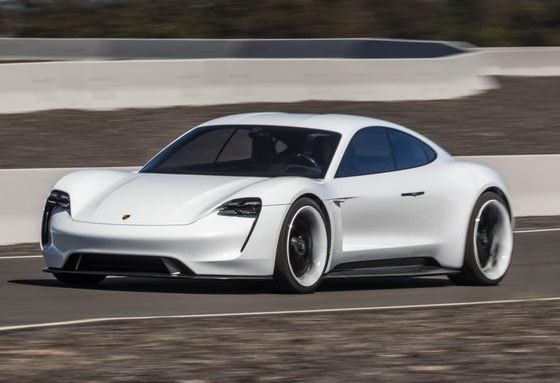

News
Porsche reveals Taycan specs: 310-mile range, ultra-fast charge 800V battery
Porsche dubs the Taycan, formerly known as the Mission E sedan, as one of its most important vehicles since the iconic Porsche 911. The upcoming all-electric, high-performance luxury sedan is expected to compete with some of the electric vehicle market’s most formidable mainstays, such as the Tesla Model S. With a drive unit developed from Porsche’s racing pedigree and battery tech that enables ultra-high-speed charging, the Taycan is set to make an impact when it starts production next year.
The auto market is starting a shift towards electric mobility, and the Taycan will be Porsche’s flag bearer for the next few years. By 2025, the legacy automaker is aiming for “every second Porsche sold to have an electric drive unit,” meaning half of its offerings would be fully electric and the other half will be plug-in hybrids. The Taycan is projected to hit a production rate of 20,000 vehicles per year, translating to roughly 67% of the current sales figures of the Porsche 911.
The Taycan is equipped with two permanently excited synchronous motors (PSM) that produce a combined 600 hp (440 kW). Porsche’s PSM motors were used by the company in the 919 Hybrid, a sports-prototype racing car that won the 24 Hours of Le Mans in the event’s Prototype-1 Hybrid (LMP1-H) category. The carmaker states that PSM electric motors are the “turbos of the electric motor milieu,” considering their capability to boast high sustained performance while maintaining maximum efficiency. Naser Abu Daqqa, director of electric drive systems at Porsche, described one of the strategies employed by the company to maximize the performance of the Taycan’s electric motors.
“The coils are made of wires that aren’t round, but rather rectangular. This makes it possible to pack the wires more tightly and get more copper into the coil machines—increasing power and torque with the same volume,” Abu Daqqa said.
Porsche’s battery unit for the Taycan is estimated to give the all-electric car a range of 310 miles per charge. In a press release, Porsche stated that lithium-ion batteries are utilized for the all-electric sedan’s battery pack. The Taycan is equipped with an 800-volt battery, comprised of cells that hold 4 volts each.
The Taycan’s battery unit prioritizes speed over weight. Instead of installing heavy batteries, Porsche opted to employ ultra-fast charging solutions instead, using an intelligent charging protocol and a heat exchanger system that can get the vehicles’ batteries up to operating temperature quickly and cooling them when needed. Due to its battery’s design, Porsche was able to use thinner cables on the vehicle as well, allowing the company to save even more weight.

The Taycan’s fast-charging system aims to add 248.5 miles worth of range in roughly 15 minutes. Dubbed the IONITY network, the ultra-fast-charging system is a joint venture with other automakers such as the BMW Group, Daimler AG, the Ford Motor Company, and the Volkswagen Group with Audi. IONITY’s chargers have a capacity of up to 350 kW per charging point, far above Tesla’s 120 kW Supercharger network. Porsche is exploring home charging solutions as well, including inductive charging via a base plate installed on a garage floor. Lastly, the Taycan will also be compatible with existing charging infrastructure in major cities.
As Porsche prepares to start manufacturing the vehicle next year, the company is currently hard at work testing prototypes of the electric car in several regions across the globe. In the western part of South Africa alone, 21 camouflaged Taycan prototypes are currently being deployed to test how the all-electric cars fare in hot weather. By the time the Taycan starts production in 2019, Porsche expects its test vehicles to have accumulated millions of kilometers worth of data from road tests.
The Taycan is expected to showcase Porsche’s trademark performance, with the vehicle being listed with a 0-60 mph time of 3.5 seconds, a range of 310 miles per charge, and a top speed of 155 mph. Pre-orders for the Taycan were recently opened to interested buyers and so far, Porsche has noted that the reception to the car has been very positive.

Elon Musk
Elon Musk’s X will start using a Tesla-like software update strategy
The initiative seems designed to accelerate updates to the social media platform, while maintaining maximum transparency.

Elon Musk’s social media platform X will adopt a Tesla-esque approach to software updates for its algorithm.
The initiative seems designed to accelerate updates to the social media platform, while maintaining maximum transparency.
X’s updates to its updates
As per Musk in a post on X, the social media company will be making a new algorithm to determine what organic and advertising posts are recommended to users. These updates would then be repeated every four weeks.
“We will make the new 𝕏 algorithm, including all code used to determine what organic and advertising posts are recommended to users, open source in 7 days. This will be repeated every 4 weeks, with comprehensive developer notes, to help you understand what changed,” Musk wrote in his post.
The initiative somewhat mirrors Tesla’s over-the-air update model, where vehicle software is regularly refined and pushed to users with detailed release notes. This should allow users to better understand the details of X’s every update and foster a healthy feedback loop for the social media platform.
xAI and X
X, formerly Twitter, has been acquired by Elon Musk’s artificial intelligence startup, xAI last year. Since then, xAI has seen a rapid rise in valuation. Following the company’s the company’s upsized $20 billion Series E funding round, estimates now suggest that xAI is worth tens about $230 to $235 billion. That’s several times larger than Tesla when Elon Musk received his controversial 2018 CEO Performance Award.
As per xAI, the Series E funding round attracted a diverse group of investors, including Valor Equity Partners, Stepstone Group, Fidelity Management & Research Company, Qatar Investment Authority, MGX, and Baron Capital Group, among others. Strategic partners NVIDIA and Cisco Investments also continued support for building the world’s largest GPU clusters.
News
Tesla FSD Supervised wins MotorTrend’s Best Driver Assistance Award
The decision marks a notable reversal for the publication from prior years, with judges citing major real-world improvements that pushed Tesla’s latest FSD software ahead of every competing ADAS system.

Tesla’s Full Self-Driving (Supervised) system has been named the best driver-assistance technology on the market, earning top honors at the 2026 MotorTrend Best Tech Awards.
The decision marks a notable reversal for the publication from prior years, with judges citing major real-world improvements that pushed Tesla’s latest FSD software ahead of every competing ADAS system. And it wasn’t even close.
MotorTrend reverses course
MotorTrend awarded Tesla FSD (Supervised) its 2026 Best Tech Driver Assistance title after extensive testing of the latest v14 software. The publication acknowledged that it had previously criticized earlier versions of FSD for erratic behavior and near-miss incidents, ultimately favoring rivals such as GM’s Super Cruise in earlier evaluations.
According to MotorTrend, the newest iteration of FSD resolved many of those shortcomings. Testers said v14 showed far smoother behavior in complex urban scenarios, including unprotected left turns, traffic circles, emergency vehicles, and dense city streets. While the system still requires constant driver supervision, judges concluded that no other advanced driver-assistance system currently matches its breadth of capability.
Unlike rival systems that rely on combinations of cameras, radar, lidar, and mapped highways, Tesla’s FSD operates using a camera-only approach and is capable of driving on city streets, rural roads, and freeways. MotorTrend stated that pure utility, the ability to handle nearly all road types, ultimately separated FSD from competitors like Ford BlueCruise, GM Super Cruise, and BMW’s Highway Assistant.
High cost and high capability
MotorTrend also addressed FSD’s pricing, which remains significantly higher than rival systems. Tesla currently charges $8,000 for a one-time purchase or $99 per month for a subscription, compared with far lower upfront and subscription costs from other automakers. The publication noted that the premium is justified given FSD’s unmatched scope and continuous software evolution.
Safety remained a central focus of the evaluation. While testers reported collision-free operation over thousands of miles, they noted ongoing concerns around FSD’s configurable driving modes, including options that allow aggressive driving and speeds beyond posted limits. MotorTrend emphasized that, like all Level 2 systems, FSD still depends on a fully attentive human driver at all times.
Despite those caveats, the publication concluded that Tesla’s rapid software progress fundamentally reshaped the competitive landscape. For drivers seeking the most capable hands-on driver-assistance system available today, MotorTrend concluded Tesla FSD (Supervised) now stands alone at the top.
News
Elon Musk’s Grokipedia surges to 5.6M articles, almost 79% of English Wikipedia
The explosive growth marks a major milestone for the AI-powered online encyclopedia, which was launched by Elon Musk’s xAI just months ago.

Elon Musk’s Grokipedia has grown to an impressive 5,615,201 articles as of today, closing in on 79% of the English Wikipedia’s current total of 7,119,376 articles.
The explosive growth marks a major milestone for the AI-powered online encyclopedia, which was launched by Elon Musk’s xAI just months ago. Needless to say, it would only be a matter of time before Grokipedia exceeds English Wikipedia in sheer volume.
Grokipedia’s rapid growth
xAI’s vision for Grokipedia emphasizes neutrality, while Grok’s reasoning capabilities allow for fast drafting and fact-checking. When Elon Musk announced the initiative in late September 2025, he noted that Grokipedia would be an improvement to Wikipedia because it would be designed to avoid bias.
At the time, Musk noted that Grokipedia “is a necessary step towards the xAI goal of understanding the Universe.”
Grokipedia was launched in late October, and while xAI was careful to list it only as Version 0.1 at the time, the online encyclopedia immediately earned praise. Wikipedia co-founder Larry Sanger highlighted the project’s innovative approach, noting how it leverages AI to fill knowledge gaps and enable rapid updates. Netizens also observed how Grokipedia tends to present articles in a more objective manner compared to Wikipedia, which is edited by humans.
Elon Musk’s ambitious plans
With 5,615,201 total articles, Grokipedia has now grown to almost 79% of English Wikipedia’s article base. This is incredibly quick, though Grokipedia remains text-only for now. xAI, for its part, has now updated the online encyclopedia’s iteration to v0.2.
Elon Musk has shared bold ideas for Grokipedia, including sending a record of the entire knowledge base to space as part of xAI’s mission to preserve and expand human understanding. At some point, Musk stated that Grokipedia will be renamed to Encyclopedia Galactica, and it will be sent to the cosmos.
“When Grokipedia is good enough (long way to go), we will change the name to Encyclopedia Galactica. It will be an open source distillation of all knowledge, including audio, images and video. Join xAI to help build the sci-fi version of the Library of Alexandria!” Musk wrote, adding in a later post that “Copies will be etched in stone and sent to the Moon, Mars and beyond. This time, it will not be lost.”








